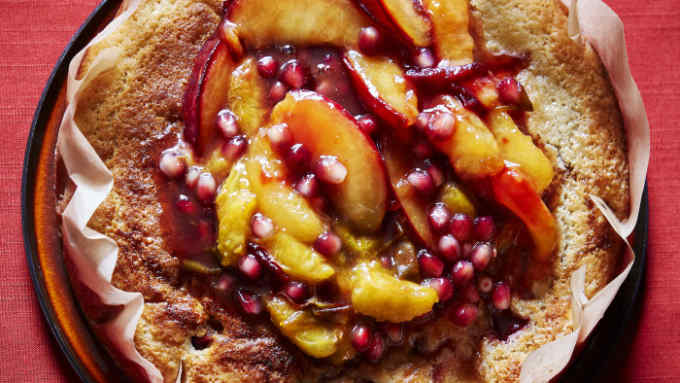Skye Gyngell’s lemon curd and meringue cake recipe

Simply sign up to the Life & Arts myFT Digest -- delivered directly to your inbox.
Lemon curd and meringue cake
This is a terrific little cake, the idea for which has its roots in a classic pavlova. We always have plenty of egg whites at work to use up. It’s very versatile — you can fill it with any fruit you like instead of the lemon curd, either fresh as is or gently poached with a little sugar. The important thing is that the fruit has a sharpness to it that helps to cut through the sweetness of the soft meringue.
It’s perfect with a cup of tea but there is no reason why you couldn’t serve it as a dessert as well.
- Preheat oven to 180C. Line two flat baking trays with parchment paper and outline a 20cm circle on each (this is most easily done by tracing the circle of a large dinner plate).
- Beat the egg whites and the salt with an electric mixer until satiny peaks form. Beat in one-third of the sugar at a time, until the meringue is stiff and shiny. Sprinkle over the cornflour, vinegar and vanilla. Fold in lightly. Mound on to the paper, then flatten the top and smooth the sides.
- Place in the oven and turn down the heat immediately to 150C. Cook for 30 minutes, then reduce the heat again to 120C and cook for 45 minutes. Turn off the oven and leave to cook completely.
- While the meringue is cooking, make the lemon curd. (You can also make this a few days in advance as it keeps well in sealed, sterilised jars.)
- Place the lemon juice, zest, caster sugar and butter in a heatproof bowl over a pan of simmering water (it is important that the bowl fits snugly inside the pan and that the base does not touch the water — you are essentially steaming the curd).
- Stir until the butter has melted, then whisk in the eggs. Keep whisking gently until the curd has reached the consistency of thick custard. Remove from the heat and strain into a sterilised jar (if keeping for some time) or into a bowl. Cover when cool, and refrigerate until ready to use.
- Place the cream into a clean bowl and whisk until thick and fairly firm.
- To assemble the cake, place one of the meringue discs on to a plate. Using a small knife or the back of a spoon, spread over the curd. Follow with cream. Place the second disc on top and finish with a layer of cream.
- Refrigerate for an hour or two before serving. This will soften the meringue, giving the cake its lovely pillowy texture.
Skye Gyngell is chef-proprietor of Spring Restaurant at Somerset House, London; springrestaurant.co.uk
The Scratch menu, which uses leftover ingredients that would otherwise go to waste, is available from 5.30pm-6.30m daily, £20 for three courses. Advance bookings only.
Follow @FTMag on Twitter to find out about our latest stories first. Subscribe to FT Life on YouTube for the latest FT Weekend videos

Comments